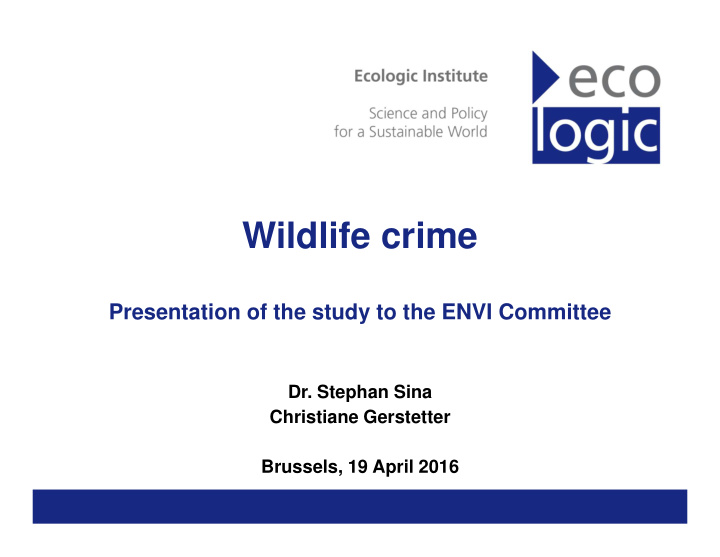



Ecologic Institute ecologic.eu Wildlife crime Presentation of the study to the ENVI Committee Dr. Stephan Sina Christiane Gerstetter Brussels, 19 April 2016
Ecologic Institute ecologic.eu Project consortium: University of South Wales Ragnhild SOLLUND, University of Oslo Teresa FAJARDO DEL CASTILLO, University of Granada Tanya WYATT, University of Northumbria Wildlife crime in the EU 2
Ecologic Institute ecologic.eu Aim of the Study Provide an overview of � the state of wildlife crime in Europe � the potential role of the EU with regards to � the effective implementation of recent policies � areas for improvement � the potential added value of an EU Action Plan on Wildlife Crime (adoption of EU Action Plan against Wildlife Trafficking by COM on 26 February 2016 ) Wildlife crime in the EU 3
Ecologic Institute ecologic.eu Method � Review of academic and official literature � Internet-based survey among 25 MS (with few responses) � Synthesis of data from EU-TWIX database � In-depth country analysis (including expert interviews) � DE, NL, PL, ES, UK � Recommendations � Also based on other findings, e.g. EFFACE project Wildlife crime in the EU 4
Ecologic Institute ecologic.eu Conclusions � The EU is both a destination (reptiles, caviar, fish, parrots, alternative medicinal products) and a transit (Mammals) region for wildlife products � Four important trade routes : � Large mammals from Africa/South America to Asia via EU trade hubs � Large mammals from Africa/South America to Asia via EU trade hubs � Coastal smuggling for the pet trade in the EU � Endangered birds from South Eastern Europe to Southern Europe � Russian wildlife and Asian exports via Eastern European land routes � Seizures : Concentrated in countries with large overall trading volumes (DE, NL, ES, FR, UK), overall trend roughly constant � Growing importance of mailing centres and of the internet Wildlife crime in the EU 5
Ecologic Institute ecologic.eu Major trade routes of illegal wildlife trade in Europe Wildlife crime in the EU 6
Ecologic Institute ecologic.eu Conclusions � The regulatory framework of the EU appears overall sufficient � Major concern: Insufficient and uneven levels of enforcement across EU � varying and often low level of sanctions � lack of resources, technical skills, awareness and expertise among police � lack of resources, technical skills, awareness and expertise among police forces, prosecutors and judicial authorities � low priority given to wildlife crime by enforcement institutions � Information from MS on sanctions varies significantly � Little information on level and quality of cooperation between agencies Wildlife crime in the EU 7
Ecologic Institute ecologic.eu Conclusions � Relevance of organised crime and money laundering to illegal wildlife trade varies between MS, but little empirical evidence available � Potential added value of EU Action Plan on wildlife crime is widely recognised (priority setting!) Wildlife crime in the EU 8
Ecologic Institute ecologic.eu Recommendations � Priority setting � Pre-condition for sufficient resources � on political (not just rhinos and elephants) and practical level � Use of targeted controls � Use of targeted controls � Demand reduction � Identify strategies for EU consumers (pet trade) � Support activities in key consumer countries � Specialisation � Provide for specialist staff (training) and specialised units at all levels Wildlife crime in the EU 9
Ecologic Institute ecologic.eu Recommendations � Cooperation � Stronger involvement of Eurojust and Europol � Funding of key actors (e.g. enforcement networks) � Data recording and access to data � Data recording and access to data � Important inter alia for targeting controls � Encourage or oblige MS to improve data collection and exchange � Sanctions � Level of sanctions must reflect seriousness of wildlife crime � Toolbox approach: diverse instruments (penal, administrative etc.) � Harmonisation of sanctions only within Environmental Crime Directive (if at all) Wildlife crime in the EU 10
Ecologic Institute ecologic.eu Recommendations � EU Action Plan � Not only enforcement, also prevention and global partnership: + � Communication to Council stresses political priority: + � No harmonisation of sanctions (only) for wildlife crime: + � No harmonisation of sanctions (only) for wildlife crime: + � Timelines and monitoring: + � Measures: Much convergence in general, some divergence in detail � Effectiveness of the EU Action Plan depends on adequate (long- term) commitment and resources dedicated to it! Wildlife crime in the EU 11
Ecologic Institute ecologic.eu Thank you for your attention! Ecologic Institute Dr. Stephan Sina Pfalzburger Str. 43/44 Stephan.sina@ecologic.eu 10717 Berlin Germany Christiane Gerstetter Tel. +49 (30) 86880-0 Christiane.gerstetter@ecologic.eu ecologic.eu Wildlife crime in the EU 12
Recommend
More recommend